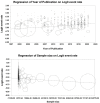Global prevalence of nosocomial infection: A systematic review and meta-analysis
- PMID: 36706112
- PMCID: PMC9882897
- DOI: 10.1371/journal.pone.0274248
Global prevalence of nosocomial infection: A systematic review and meta-analysis
Abstract
Objectives: Hospital-acquired infections (HAIs) are significant problems as public health issues which need attention. Such infections are significant problems for society and healthcare organizations. This study aimed to carry out a systematic review and a meta-analysis to analyze the prevalence of HAIs globally.
Methods: We conducted a comprehensive search of electronic databases including EMBASE, Scopus, PubMed and Web of Science between 2000 and June 2021. We found 7031 articles. After removing the duplicates, 5430 studies were screened based on the titles/ abstracts. Then, we systematically evaluated the full texts of the 1909 remaining studies and selected 400 records with 29,159,630 participants for meta-analysis. Random-effects model was used for the analysis, and heterogeneity analysis and publication bias test were conducted.
Results: The rate of universal HAIs was 0.14 percent. The rate of HAIs is increasing by 0.06 percent annually. The highest rate of HAIs was in the AFR, while the lowest prevalence were in AMR and WPR. Besides, AFR prevalence in central Africa is higher than in other parts of the world by 0.27 (95% CI, 0.22-0.34). Besides, E. coli infected patients more than other micro-organisms such as Coagulase-negative staphylococci, Staphylococcus spp. and Pseudomonas aeruginosa. In hospital wards, Transplant, and Neonatal wards and ICU had the highest rates. The prevalence of HAIs was higher in men than in women.
Conclusion: We identified several essential details about the rate of HAIs in various parts of the world. The HAIs rate and the most common micro-organism were different in various contexts. However, several essential gaps were also identified. The study findings can help hospital managers and health policy makers identify the reason for HAIs and apply effective control programs to implement different plans to reduce the HAIs rate and the financial costs of such infections and save resources.
Copyright: © 2023 Raoofi et al. This is an open access article distributed under the terms of the Creative Commons Attribution License, which permits unrestricted use, distribution, and reproduction in any medium, provided the original author and source are credited.
Conflict of interest statement
The authors have declared that no competing interests exist.
Figures





Comment in
-
Hospital-onset bacteremia: clinical and regulatory ramifications.Future Microbiol. 2023 Nov;18:1133-1136. doi: 10.2217/fmb-2023-0199. Epub 2023 Oct 30. Future Microbiol. 2023. PMID: 37902608
References
-
- Šuljagić V., et al.., A nationwide assessment of the burden of healthcare-associated infections and antimicrobial use among surgical patients: results from Serbian point prevalence survey, 2017. Antimicrob Resist Infect Control, 2021. 10(1): p. 47. doi: 10.1186/s13756-021-00889-9 - DOI - PMC - PubMed
-
- Gozel M.G., et al.., National Infection Control Program in Turkey: The healthcare associated infection rate experiences over 10 years. American Journal of Infection Control, 2021. - PubMed
Publication types
MeSH terms
LinkOut - more resources
Full Text Sources
Miscellaneous

